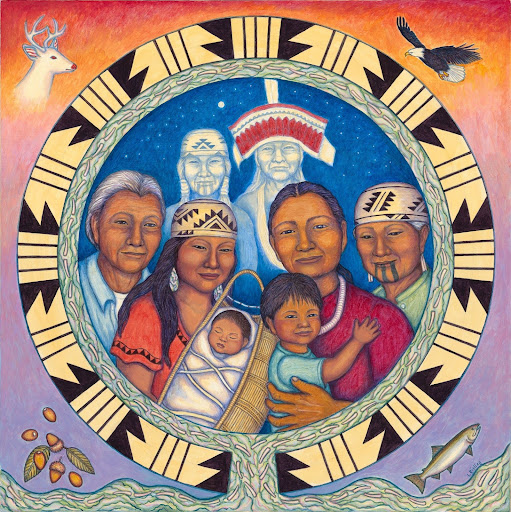Overview
We are Still Here: Resilience and Healing

Authors and Collaborators:
Maggie Peters, Yurok/Karuk Educator, Traditional Basket Weaver, Cultural Preservationist, Native American Studies Model Curriculum Learning Specialist at Humboldt County Office of Education
Lyn Risling, Karuk/Yurok/Hupa Artist, Author, Illustrator, Ceremonial Leader
Julian Lang, Karuk Linguist, Artist
- Video support provided by Joanna Galicha, Graphics & Communications Specialist at Humboldt County Office of Education
We Are Still Here, Fix the World People Unit (Lesson 4 of 6)
- Lesson 1: Notice Wonder Feel
- Lesson 2: Lyn Risling, Karuk, Hupa, and Yurok Artist
- Lesson 3: History and Survival
- Lesson 4: Resilience and Healing
- Lesson 5: Ararachúupha Nuu Payêem Nuchúuphitih (We Are Talking Our Indian Language Now)
- Lesson 6: Expression of Self - Art Inspired by Lyn Risling
Grade: 7
Suggested Amount of Time: 50-55 minutes (designed for multi-period schedule typical of middle schools)
Curriculum Themes
- Cultural Strengths
- Relationship to Place
- Cross Curricular Integration
Learning Goals
- Understand how language is deeply connected to cultural identity, worldview, and traditions.
- Foster empathy toward the historical impact of colonization on Indigenous languages and how language revitalization is cultural survival and healing.
- Experience how art reflects resilience, survival and cultural values.
- Engage in Karuk language immersion.
Lesson Overview
This lesson explores the significance of language revitalization in Indigenous communities, featuring the Karuk Language of northwestern California. Inspired by Lyn Risling’s painting “We Are Still Here, Fix the World People”, students will explore themes of resilience, survival, and cultural identity. Julian Lang, Karuk Linguist, describes the painting in the Karuk language providing students an experience to better understand how language serves as a critical tool for preserving culture and world view. This lesson emphasizes that language, once nearly lost due to violent colonization, was kept and has continued to be the focus for revitalization by the Karuk people as a pathway to healing and cultural reclamation. Students will gain an appreciation for the power of language in maintaining connections to heritage and+ the importance of supporting language preservation efforts. Ultimately, this lesson fosters an understanding of how language revitalization is not just about communication, but about reclaiming identity, community resilience, and promoting healing from the historical trauma of assimilation and systematic cultural erasure.
Teacher Background
This lesson focuses on the power of language revitalization in Indigenous communities, using the painting We Are Still Here, Fix the World People by Lyn Risling as a key visual entry point. The lesson underscores how language preservation serves not only as a means of communication but as a crucial tool for healing, cultural identity, and resilience in the face of historical trauma. The Karuk, along with other Indigenous peoples, have faced the systematic erasure of their languages and cultures due to colonization, but through language revitalization efforts, they are reclaiming their identity and power.
As an educator, it’s essential to approach this topic with sensitivity and respect, understanding that the history of colonization, forced assimilation, and language loss is deeply painful for many Indigenous communities. Language revitalization is part of a larger movement of cultural reclamation, and it provides a pathway to healing and empowerment. Research shows that language plays a significant role in the mental and physical well-being of Indigenous peoples. According to studies like Healing, Support, Empowerment: How Language Revitalization Can Mitigate Trauma (Tribal College Journal), Indigenous language revitalization can serve as a form of emotional and psychological healing. The act of reclaiming language helps individuals connect to their cultural roots and community, fostering a sense of belonging and empowerment, and mitigating the trauma caused by generations of forced displacement and cultural erasure.
Additionally, the Health Effects of Indigenous Language Use and Revitalization (International Journal of Equity and Health) highlights the connection between language use and health, demonstrating how the revitalization of Indigenous languages can enhance well-being, reduce stress, and create a sense of pride and continuity. This is particularly important in Indigenous communities, where historical trauma has had enduring effects on mental health. The act of preserving and teaching Indigenous languages helps mend intergenerational wounds, allowing younger generations to reconnect with their heritage and the values that sustain it.
When teaching this lesson, it’s important to emphasize that language is a way for Indigenous peoples to express worldviews, histories, and relationships to land, ancestors, and each other. It fosters resilience, empowering people to reclaim their place in the world after centuries of oppression. By approaching this lesson with a deep sense of cultural respect and an understanding of the trauma involved, students will appreciate the boader significance of language preservation, not only as an academic exercise but as a tool for cultural resilience and healing.

